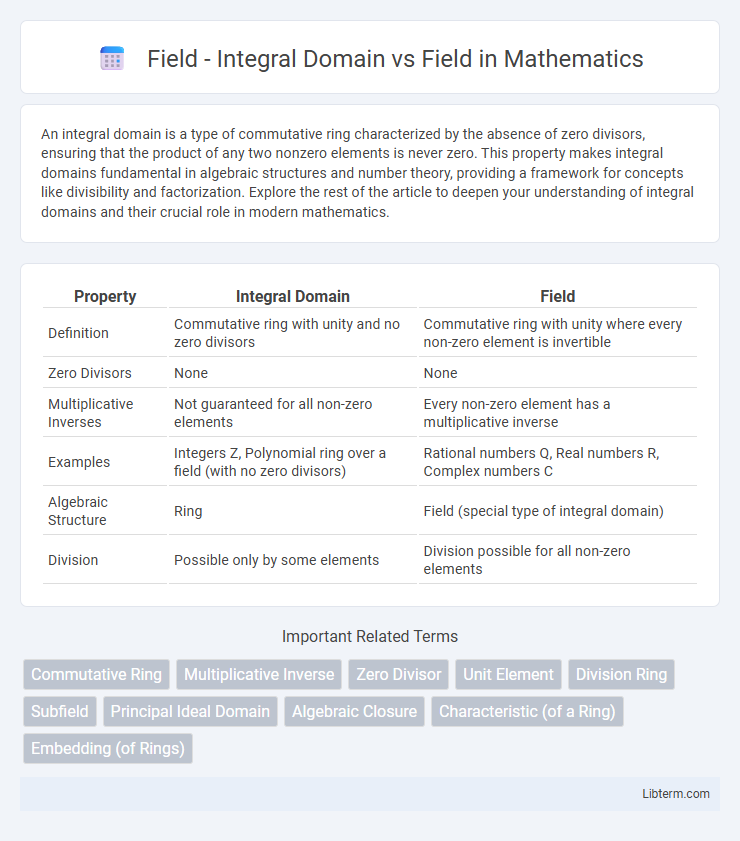An integral domain is a type of commutative ring characterized by the absence of zero divisors, ensuring that the product of any two nonzero elements is never zero. This property makes integral domains fundamental in algebraic structures and number theory, providing a framework for concepts like divisibility and factorization. Explore the rest of the article to deepen your understanding of integral domains and their crucial role in modern mathematics.
Table of Comparison
| Property | Integral Domain | Field |
|---|---|---|
| Definition | Commutative ring with unity and no zero divisors | Commutative ring with unity where every non-zero element is invertible |
| Zero Divisors | None | None |
| Multiplicative Inverses | Not guaranteed for all non-zero elements | Every non-zero element has a multiplicative inverse |
| Examples | Integers Z, Polynomial ring over a field (with no zero divisors) | Rational numbers Q, Real numbers R, Complex numbers C |
| Algebraic Structure | Ring | Field (special type of integral domain) |
| Division | Possible only by some elements | Division possible for all non-zero elements |
Introduction to Algebraic Structures
A field is an algebraic structure where every nonzero element has a multiplicative inverse, ensuring commutative multiplication and additive identity properties. An integral domain is a commutative ring with unity that contains no zero divisors, allowing unique factorization without requiring multiplicative inverses for all nonzero elements. Understanding these distinctions clarifies the hierarchy of algebraic structures crucial in abstract algebra and number theory.
Defining Fields: Key Properties
A field is an algebraic structure in which every nonzero element has a multiplicative inverse, ensuring the existence of division operations, while an integral domain only requires the absence of zero divisors and closure under addition and multiplication. Fields always exhibit commutativity in both addition and multiplication, possess an additive identity (0), multiplicative identity (1), and support distributivity of multiplication over addition. Unlike integral domains, fields guarantee every nonzero element a multiplicative inverse, making fields essential for defining division rings and enabling polynomial factorization in abstract algebra.
What is an Integral Domain?
An integral domain is a commutative ring with unity that has no zero divisors, meaning the product of any two nonzero elements is nonzero. It generalizes fields by allowing elements without multiplicative inverses, unlike fields where every nonzero element must have an inverse. Integral domains form the foundation for constructing fields via field of fractions, making them crucial in algebraic structures and number theory.
Core Differences: Field vs Integral Domain
A field is an algebraic structure in which every nonzero element has a multiplicative inverse, making division always possible except by zero, whereas an integral domain is a commutative ring with no zero divisors but does not guarantee inverses for all nonzero elements. In an integral domain, cancellation law holds due to the absence of zero divisors, but not every nonzero element is invertible, distinguishing it from a field. The core difference lies in the presence of multiplicative inverses for all nonzero elements in fields, a property absent in integral domains.
Examples of Fields and Integral Domains
Examples of fields include the set of rational numbers (Q), real numbers (R), and complex numbers (C), where every nonzero element has a multiplicative inverse. Integral domains include the set of integers (Z) and polynomial rings over a field, such as R[x], which contain no zero divisors but may lack inverses for all nonzero elements. The distinction hinges on fields being commutative rings with unity where division is always possible (excluding zero), while integral domains only require the absence of zero divisors.
Zero Divisors: A Critical Distinction
An integral domain is a commutative ring with no zero divisors, ensuring that the product of any two non-zero elements is always non-zero, which preserves the integrity of multiplication. In contrast, a field not only lacks zero divisors but also guarantees every non-zero element has a multiplicative inverse, enabling division by any non-zero element. The absence of zero divisors in integral domains is a critical distinction that allows for the cancellation law in multiplication, a property essential for fields but not sufficient on its own to constitute a field.
Role of Inverses in Each Structure
In a field, every nonzero element has a multiplicative inverse, enabling division and forming a commutative group under multiplication. An integral domain lacks zero divisors but only requires multiplicative inverses for 1, not for all elements, restricting division operations. The presence of inverses in fields leads to richer algebraic structures, facilitating solutions to equations and allowing polynomial factorization techniques unavailable in integral domains.
Applications in Mathematics and Beyond
Integral domains provide the foundation for polynomial ring theory and algebraic number theory, critical in cryptographic algorithms and error-correcting codes. Fields extend these applications by enabling vector space theory, linear algebra, and Galois theory, which are essential in coding theory, cryptography, and systems of linear equations. Both structures influence computer science, physics, and engineering through their roles in solving equations and modeling systems with algebraic structures.
Hierarchy and Relationship in Abstract Algebra
An integral domain is a commutative ring with no zero divisors, forming a foundational structure in abstract algebra, while a field is a special type of integral domain where every nonzero element has a multiplicative inverse. The hierarchy places fields as a strict subset within integral domains, ensuring that all fields satisfy integral domain properties but not vice versa. Understanding this relationship highlights fields as integral domains with enhanced algebraic properties, crucial for applications in number theory, algebraic geometry, and vector space theory.
Summary Table: Field vs Integral Domain
A field is a commutative ring with unity where every nonzero element has a multiplicative inverse, ensuring division is always possible. An integral domain is a commutative ring with unity without zero divisors, but not every nonzero element necessarily has an inverse. The summary table highlights a field's stricter structure, enabling division, while an integral domain allows multiplication and addition but lacks guaranteed element invertibility.
Field - Integral Domain Infographic

 libterm.com
libterm.com